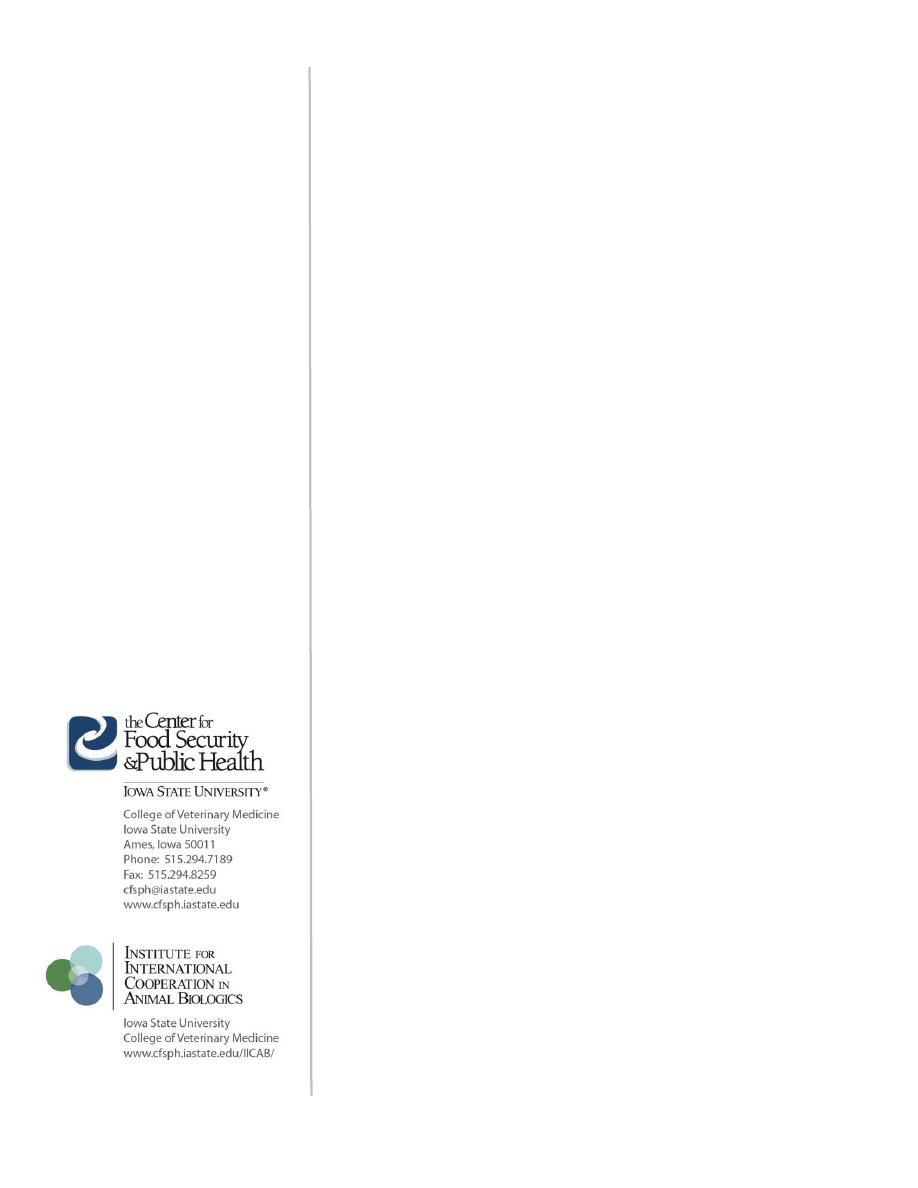
© 2009
page 1 of 4
Equine
Infectious Anemia
Swamp Fever,
Mountain Fever,
Slow Fever,
Equine Malarial Fever,
Coggins Disease
Last Updated: August 2009
Importance
Equine infectious anemia (EIA) is a retroviral disease of equids that may be
characterized by acute and/or chronic recurring clinical signs including fever, anemia,
edema and cachexia in some animals. Many horses have very mild or inapparent signs
on first exposure, and carry this virus subclinically. The owners of these animals are
unlikely to realize that they are infected unless serological testing is done. All infected
horses, including those that are asymptomatic, become carriers and are infectious for
life. Infected animals must either be destroyed or remain permanently isolated from
other equids to prevent transmission.
Etiology
Equine infectious anemia is caused by equine infectious anemia virus (EIAV), a
lentivirus in the family Retroviridae (subfamily Orthoretrovirinae).
Species Affected
Equine infectious anemia virus is reported to infect all members of the Equidae.
Clinical cases occur in horses and ponies (Equus caballus), and have also been
reported in mules. Some horse-adapted viral isolates replicate to low levels without
clinical signs in donkeys (E. asinus); however, unpublished evidence suggests that
serially-passaged, donkey-adapted isolates may be pathogenic for this species.
Geographic Distribution
Equine infectious anemia has been found nearly worldwide. This disease appears
to be absent from a few countries including Iceland and Japan.
Transmission
Equine infectious anemia virus is transmitted mechanically on the mouthparts of
biting insects. In horses, this virus persists in blood leukocytes for life, and also
occurs in plasma during febrile episodes. Symptomatic horses are more likely to
transmit the disease than animals with inapparent infections; after visiting an
asymptomatic carrier, only one out of every 6 million flies is likely to become a
vector. High levels of viremia have also been reported during the early stages of the
infection in mules. Significantly lower titers have been reported in donkeys inoculated
with certain horse-adapted strains.
Although other insects including stable flies (Stomoxys calcitrans) can transmit
EIAV, the most effective vectors are biting flies in the family Tabanidae, especially
horse flies (Tabanus spp. and Hybomitra spp.) and deer flies (Chrysops spp.). The
bites of these flies are painful, and the animal’s reaction interrupts feeding. The fly
attempts to resume feeding immediately, either on the same animal or on another
nearby host, resulting in the transfer of infectious blood. EIAV survives for a
limited time on the mouthparts of insects, and it is less likely to be spread to more
distant hosts. This virus can also be transmitted in blood transfusions or on
contaminated needles, surgical instruments and teeth floats. It is reported to persist
for up to 96 hours on hypodermic needles. EIAV may also be passed from a mare to
her foal in utero.
Other, minor routes of transmission might be possible. EIAV does not appear to
be shed in saliva or urine. However, it can be found in milk and semen, and horses
can be infected by inoculating these secretions subcutaneously. Possible transmission
through milk has been reported in some nursing foals. Although venereal transmission
does not seem to be a major route of spread, one stallion appears to have transmitted
the virus to a mare with a vaginal tear during breeding. The possibility of aerosol
transmission by infectious material during close contact was raised during the 2006
outbreak in Ireland.
Incubation Period
The incubation period is a week to 45 days or longer. Some horses remain
asymptomatic until they are stressed.

Equine Infectious Anemia
Last Updated: August 2009
© 2009
page 2 of 4
Clinical Signs
The clinical signs of acute EIA are often nonspecific.
In some cases in horses, the only sign is a fever, which is
sometimes accompanied by transient inappetence. In mild
cases, the fever can last less than 24 hours. More severely
affected horses can become weak, depressed and
inappetent, with additional signs that may include jaundice,
tachypnea,
tachycardia,
ventral
pitting
edema,
thrombocytopenia, petechiae on the mucus membranes,
epistaxis or blood–stained feces. Anemia can occur,
although it is more likely to be severe in chronically
infected animals. Occasionally, horses become gravely ill
and may die during the acute stage. After the initial bout,
most horses become asymptomatic carriers; however, some
animals develop recurring clinical signs that vary from mild
illness and failure to thrive to fever, depression, petechial
hemorrhages on the mucus membranes, weight loss, anemia
and dependent edema. Inapparent infections may become
symptomatic during concurrent illnesses, severe stress or
hard work. Death is possible during these febrile episodes.
Ophthalmic lesions, characterized by depigmentation with
prominent choroidal vessels, have been reported in
chronically infected horses.
Donkeys and mules are less likely to develop severe
clinical signs. Mules can be infected asymptomatically, but
typical EIA signs have been reported in some naturally or
experimentally infected animals. In a recent experiment,
donkeys inoculated with two horse-adapted strains became
infected but remained asymptomatic. Donkeys inoculated
with a serially-passaged, donkey-adapted strain in China are
reported to have developed clinical signs.
Post Mortem Lesions
The spleen, liver and abdominal lymph nodes may be
enlarged, and the mucous membranes can be pale. In
chronic cases, emaciation may also be noted. Edema is
often found in the limbs and along the ventral abdominal
wall. Petechiae may be observed on internal organs,
including the spleen and kidney. Mucosal and visceral
hemorrhages and blood vessel thrombosis have also been
reported. Chronically infected horses that die between
clinical episodes usually have no gross lesions, but some
animals may have proliferative glomerulonephritis or ocular
lesions.
Morbidity and Mortality
The infection rate varies with the geographic region.
Virus transmission is influenced by the number and species
of flies, their habits, the density of the horse population, the
level of viremia in the host and the quantity of blood
transferred. Infections are particularly common in humid,
swampy regions. Seroprevalence rates as high as 70% have
been seen on farms where the disease has been endemic for
many years. The morbidity rate and severity of the clinical
signs are influenced by the strain and dose of the virus, and
the health of the animal. Horses are more likely to develop
clinical signs than donkeys or mules, but many horses are
infected subclinically. The presence of EIAV in a herd
often goes unnoticed until some horses develop the chronic
form of the disease or routine testing is done. Epizootics
with high morbidity and mortality rates have been reported,
but deaths are otherwise uncommon in naturally infected
horses. Experimental inoculation with a high viral dose can
result in mortality rates as high as 80%.
Diagnosis
Clinical
Equine infectious anemia should be among the
differentials in individual horses with weight loss, edema
and intermittent fever. It should also be considered when
several
horses
experience
fever,
anemia,
edema,
progressive weakness or weight loss, particularly when new
animals have been introduced into the herd or a member of
the herd has died.
Differential diagnosis
The differential diagnosis includes other febrile
illnesses
including
equine
viral
arteritis,
purpura
hemorrhagica, leptospirosis, babesiosis, severe strongyliasis
or
fascioliasis,
phenothiazine
toxicity,
autoimmune
hemolytic anemia and other diseases that cause fever,
edema and/or anemia.
Laboratory tests
Equine infectious anemia is often confirmed by
serology. Once an animal is infected, it becomes a carrier
for life. The two most commonly used serological tests are
the agar gel immunodiffusion (AGID or Coggins) test and
enzyme-linked immunosorbent assays (ELISAs). Horses
are usually seronegative in the AGID test during the first 2-
3 weeks after infection; in rare cases, they may not develop
antibodies until 60 days. ELISAs can detect antibodies
earlier than the AGID test and are more sensitive, but false
positives are more likely to occur. For this reason, positive
results on ELISA are confirmed with the AGID test or
immunoblotting (Western blotting). Limited experimental
evidence suggests that antibody production may be delayed
in donkeys and mules.
Reverse-transcriptase polymerase chain reaction (RT-
PCR) assays can also be used to detect infected horses.
These tests are valuable in determining the infection status
of foals born to infected mares, because young animals may
have maternal antibodies up to the age of 6-8 months. PCR
tests can also be used to supplement or confirm serological
tests, particularly when there are conflicting results or when
an infection is suspected but serology is negative or
equivocal (e.g., in early cases where antibodies have not
developed). In addition, this technique can ensure that
blood donors and horses used for vaccine or antiserum
production are uninfected. RT-PCR appears to be an
effective method of diagnosis in mules as well as horses.

Equine Infectious Anemia
Last Updated: August 2009
© 2009
page 3 of 4
Virus isolation is not usually required for a diagnosis,
but it can be done. EIAV may be found in both plasma
and blood leukocytes during febrile episodes; between
these periods, this virus is cell-associated. Virus isolation
is performed in horse leukocyte cultures; because these
cells are difficult to grow, this test may not be available in
all laboratories. The identity of the virus can be confirmed
with antigen-specific ELISAs, immunofluorescence tests
or PCR.
If the status of an equid cannot be determined by other
methods, blood may be inoculated into a susceptible horse.
Antibody status and clinical signs in the test animal are
monitored for at least 45 days.
Samples to collect
Serum should be collected for serology. Blood samples
are taken for RT-PCR, virus isolation or inoculation into a
test animal.
Recommended actions if
equine infectious anemia is suspected
Notification of authorities
Equine infectious anemia is a reportable disease in
many states. Each state should be checked for specific
regulations.
Federal: Area Veterinarians in Charge (AVIC):
http://www.aphis.usda.gov/animal_health/area_offices/
State Veterinarians:
http://www.usaha.org/Portals/6/StateAnimalHealthOfficials
.pdf
Control
Many countries have control programs requiring equids
to be tested for equine infectious anemia. State regulations
in the U.S. vary, but most states require one or more tests,
particularly before entry of the horse into the state,
participation in organized activities and/or sale of the horse.
Regular voluntary testing of the equids on a farm, as well as
testing of new animals before introduction, is helpful in
maintaining an EIA-free herd. No vaccine is available.
Infected equids become lifelong carriers, and must be
permanently isolated from other susceptible animals or
euthanized. In the U.S., a reactor must be marked with a
brand, freezemarking or a lip tattoo before it is moved
between states. Reactors can only be transported between
states if they are going to their home farms, a
slaughterhouse, or a diagnostic or research facility, and
they must move under quarantine conditions. Most states
also require that reactors be marked if they remain within
the state. The risk of transmission from carriers varies, but
because it is impossible to quantify this risk, all infected
horses are treated alike. Asymptomatic carriers often give
birth to uninfected foals. The risk of congenital infection
is higher if the mare has clinical signs before she gives
birth. Foals born to infected mares should be isolated from
other equids until the foal is determined to be free of
infection.
During an outbreak, spraying to control insect vectors,
as well as the use of insect repellents and insect-proof
stabling, may aid in interrupting transmission. Placing
animals in small groups separated by at least 200 yards
might be beneficial when the virus is being transmitted
within a farm. Care should be taken to prevent iatrogenic
transmission. In countries where equine infectious anemia
is not present, outbreaks are contained with quarantines and
movement controls, tracing of cases and surveillance.
Enveloped viruses such as EIAV are readily destroyed by
most common disinfectants. This virus does not persist in
insects, which are mechanical vectors.
Public Health
There is no evidence that equine infectious anemia is a
threat to humans.
Internet Resources
American Association for Horsemanship Safety (AAHS).
Your Horse, Equine Infectious Anemia and the Law.
http://asci.uvm.edu/equine/law/horselaw/eia.htm
AAHS. Equine Infectious Anemia Statutes and
Administrative Regulations for Individual States
http://asci.uvm.edu/equine/law/eia/eia.htm
Food and Agriculture Organization of the United Nations
(FAO). Manual for the Recognition of Exotic Diseases
of Livestock
The Merck Veterinary Manual
http://www.merckvetmanual.com/mvm/index.jsp
USDA APHIS. Equine Infectious Anemia Disease
Information
http://www.aphis.usda.gov/animal_health/animal_disea
ses/eia/
World Organization for Animal Health (OIE)
OIE Manual of Diagnostic Tests and Vaccines for
Terrestrial Animals
http://www.oie.int/international-standard-
setting/terrestrial-manual/access-online/
OIE Terrestrial Animal Health Code
http://www.oie.int/international-standard-
setting/terrestrial-code/access-online/
References
Brangan P, Bailey DC, Larkin JF, Myers T, More SJ.
Management of the national programme to eradicate equine
infectious anaemia from Ireland during 2006: a review. Equine
Vet J. 2008;40(7):702-4.

Equine Infectious Anemia
Last Updated: August 2009
© 2009
page 4 of 4
Cook SJ, Cook RF, Montelaro RC, Issel CJ. Differential responses
of Equus caballus and Equus asinus to infection with two
pathogenic strains of equine infectious anemia virus.Vet
Microbiol. 2001;79(2):93-109.
Dawson RO. Your horse, equine infectious anemia and the law
[online]. American Association for Horsemanship Safety.
Available at:
http://asci.uvm.edu/equine/law/horselaw/eia.htm
Accessed 3 Jul 2009.
Garner G, Saville P, Fediaevsky A. Manual for the recognition of
exotic diseases of livestock: A reference guide for animal
health staff [online]. Food and Agriculture Organization of the
United Nations [FAO]; 2003. Equine viral arteritis. Available
at:
. Accessed 1 Jul 2009.
Hall FR, Pursell AR, Cole JR, Youmans BC. A propagating
episode of equine infectious anemia on a horse farm.
1988;193(9): 1082-1084.
Issel CJ, Rushlow K, Foil LD, Montelaro RC. A perspective on
equine infectious anemia with an emphasis on vector
transmission and genetic analysis. Vet Microbiol.
1988;17(3):251-86.
More SJ, Aznar I, Myers T, Leadon DP, Clegg A. An outbreak of
equine infectious anaemia in Ireland during 2006: the modes
of transmission and spread in the Kildare cluster. Equine Vet
J. 2008;40(7):709-11.
United States Government. Code of Federal Regulations Title 9,
Chapter I, Subchapter C, Part 75. Communicable diseases in
horses, asses, ponies, mules, and zebras. Equine infectious
anemia (swamp fever). Interstate movement of equine
infectious anemia reactors and approval of laboratories,
diagnostic facilities, and research facilities. Available at:
. Accessed 13 Jul 2009.
Kahn CM, Line S, editors. The Merck veterinary manual [online].
Whitehouse Station, NJ: Merck and Co; 2006. Equine
infectious anemia. Available at:
http://www.merckvetmanual.com/mvm/index.jsp?cfile=htm/b
c/52800.htm
. Accessed 21 Jun 2009.
Kemen MJ Jr, Coggins L. Equine infectious anemia: transmission
from infected mares to foals. J Am Vet Med Assoc.
1972;161(5):496-9.
Motie A. An outbreak of suspected equine infectious anaemia in
Guyana. Br Vet J. 1986;142:36-40
Murphy FA, Gibbs EPJ, Horzinek MC, Studdert MJ, editors.
Veterinary virology. San Diego, CA: Academic Press; 1999.
Equine infectious anemia;. p. 575-576.
Sellon DC. Equine infectious anemia.Vet Clin North Am Equine
Pract. 1993;9(2):321-36.
Spyrou V, Papanastassopoulou M, Psychas V, Billinis Ch,
Koumbati M, Vlemmas J, Koptopoulos G. Equine infectious
anemia in mules: virus isolation and pathogenicity studies. Vet
Microbiol. 2003;95(1-2):49-59.
Stein CD, Osteen OL, Mott LO, Shahan MS. Experimental
transmission of equine infectious anemia by contact and body
secretions and excretions. Vet Med. 1944;39:46-51.
Stein CD, Mott LO. Studies on congenital transmission of equine
infectious anemia . Vet Med. 1942;37:37-77.
Tashjian RJ. Transmission and clinical evaluation of an equine
infectious anemia herd and their offspring over a 13-year
period. J Am Vet Med Assoc. 1984;184(3):282-288.
United States Department of Agriculture. Animal and Plant Health
Inspection Service, Veterinary Services, Centers for
Epidemiology and Animal Health [USDA APHIS, VS,
CEAH]. National Animal Health Monitoring System. Equine
infectious anemia [online]. USDA APHIS, VS, CEAH; 1996
Oct. Available at:
http://www.aphis.usda.gov:80/oa/pubs/fseia.html.* Accessed
26 Sept 2001.
World Organization for Animal Health (OIE). World animal health
information database (WAHID) [database online]. Equine
infectious anemia. Paris:OIE;2009. Available at:
http://www.oie.int/wahis/public.php?page=disease_status_lists
Accessed 20 Jun 2009.
World Organization for Animal Health (OIE). Manual of
diagnostic tests and vaccines for terrestrial animals [online].
Paris: OIE; 2008. Equine infectious anemia. Available at:
http://www.oie.int/eng/normes/mmanual/2008/pdf/2.05.06_EI
A.pdf
. Accessed 21 Jun 2009.
*Link defunct as of 2009
